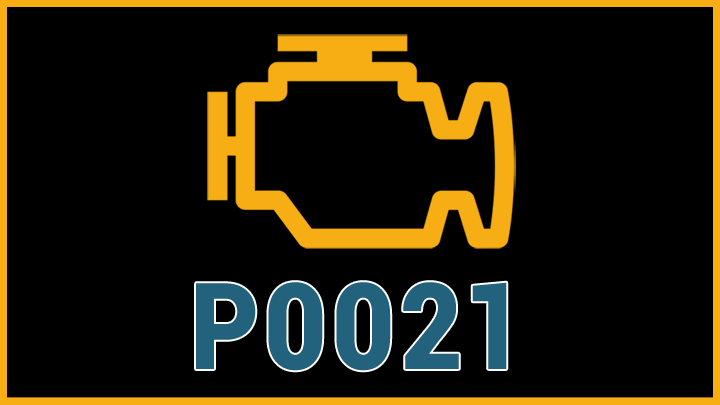P0021 Code (Symptoms, Causes, and How to Fix)
Variable valve timing optimizes engine performance. But VVT issues trigger codes like P0021 for camshaft over-advancement. This fault confuses computer controls, resulting in various issues.
Learn what causes a P0021 code, how severe the problem is, and how to properly diagnose and fix it.

What Does Code P0021 Mean?
Diagnostic trouble code P0021 applies to vehicles that feature Variable Valve Timing (VVT), or Variable Camshaft Timing (VCT). More specifically, this code implies that the timing of an engine’s bank-2 camshaft has reached a state of consistency over advancement. Conversely, code P0022 would signal an over-retarded state.
Engines that utilize VVT or VCT (ie: VTEC, VVTI, etc.) modify the timing of each camshaft through the use of a specialized cam phaser. These phasers change the orientation of each corresponding camshaft, by applying or reducing the volume of oil applied to individual lobes of an internal rotor.
This, in turn, allows for additional rotational movement of an engine’s camshaft, outside of that applied by the timing chain.
Variances in camshaft timing, achieved through the use of cam phasers, impact the actuation of an engine’s intake and exhaust valves. As a byproduct of this technology, combustion efficiency can be adjusted as necessary in real-time.
In the case of DTC P0021, a vehicle’s ECM/PCM has determined that an engine’s bank-2 camshaft is displaying g signs of being overly advanced in timing. Because of this, combustion efficiency on this particular engine bank is negatively impacted.
Related DTCs: P0008, P0010, P0011, P0013, P0016,
Symptoms of Code P0021

Diagnostic fault code P0021 is often accompanied by a host of secondary issues, some of which tend to be far more severe in nature than others. By learning to recognize these symptoms, you can expedite the diagnostic process, thereby minimizing vehicle downtime.
The following are several of the most common symptoms associated with DTC P0021.
- Illuminated check engine light
- Hard starting
- Erratic or irregular idle
- Stalling
- Reduced fuel economy
Causes of Code P0021

Diagnostic trouble code P0021 can often be traced back to one of several potential causes, some of which prove more tedious to pinpoint than others. Understanding each of these potential issues typically proves beneficial when striving to make all necessary repairs in a timely manner.
The following are several of the most common causes of DTC P0021.
- Out-of-phase camshaft timing
- Faulty timing control solenoid valve
- Electrical issues pertaining to the intake timing control valve system
- Damaged timing chain, guide, or tensioner
- Inadequate engine oil
- Compromised ECM/PCM
Is Code P0021 Serious?
In the vast majority of instances, diagnostic trouble code P0021 is regarded as being quite serious in nature. This is due to the fact that this particular code is often accompanied by a host of severe symptoms, which tend to negatively impact a vehicle’s drivability. Generally speaking, these symptoms only tend to increase in severity with the passage of time.
In the most severe of cases, diagnostic trouble code P0021 can even be accompanied by starting difficulties or engine stalling. This poses a risk of becoming stranded or losing control over power-assisted vehicle functions while in transit. As such, this leads to much more than an inconvenience of sorts, but a potential safety liability as well.
In any event, the root cause of diagnostic trouble code P0021 should be thoroughly diagnosed and repaired as soon as possible. Doing so minimizes the above-mentioned hazards, and ensures a speedy return to service for your vehicle.
If you do not feel comfortable attempting to making repairs on your own, make an appointment with a trusted auto service center at the first available opportunity.
How to Fix a Code P0021

The following steps can be used to assist you in diagnosing and repairing the root cause of your vehicle ́s P0021 fault code. As always, be sure to consult factory-specific service literature for your particular vehicle, before attempting any such repairs.
#1 – Scan For Additional DTCs
Before beginning the diagnostic process, check for the presence of any additional diagnostic fault codes. Any such fault codes should be thoroughly diagnosed before proceeding.
#2 – Analyze Oil Level
Begin by checking your vehicle’s oil level. Relatively clean oil should be present up to the full mark on a vehicle’s dipstick. If this is not the case, an engine’s oil should be topped off before proceeding.
#3 – Inspect Wiring to Solenoid Valve
Next, perform a careful visual inspection of the wiring harness that routes to your engine’s bank-2 camshaft timing solenoid valve. Ensure that all connections are made and that no obvious damage to any of the circuit’s wiring is evident.
#4 – Check Solenoid Resistance
You will now check the internal resistance of your engine’s bank-2 camshaft timing solenoid. This can be done with the use of any quality digital multimeter.
Any measure of resistance should be compared to that specified by a vehicle’s manufacturer. Out of specification readings will necessitate replacement.
See Also: Bank 1 vs Bank 2 Location
#5 – Back-Probe Wiring
Assuming that the internal resistance of your engine’s camshaft timing solenoid is correct, it will be necessary to back-probe the connection at this sensor, in a bid to distinguish whether or not power/ground is being delivered to the sensor itself.
A lack of power or ground will require further electrical diagnosis, while correct power/ground delivery will require one to consult model-specific service literature for their vehicle, as a means of inspecting engine timing and oil distribution.
- P0480 Code (Symptoms, Causes, and How to Fix) - Apr 19, 2024
- Car Temperature Gauge Stopped Working? (Here’s Why) - Apr 15, 2024
- Ignition Coil vs Coil Pack (What’s the Difference?) - Apr 8, 2024
